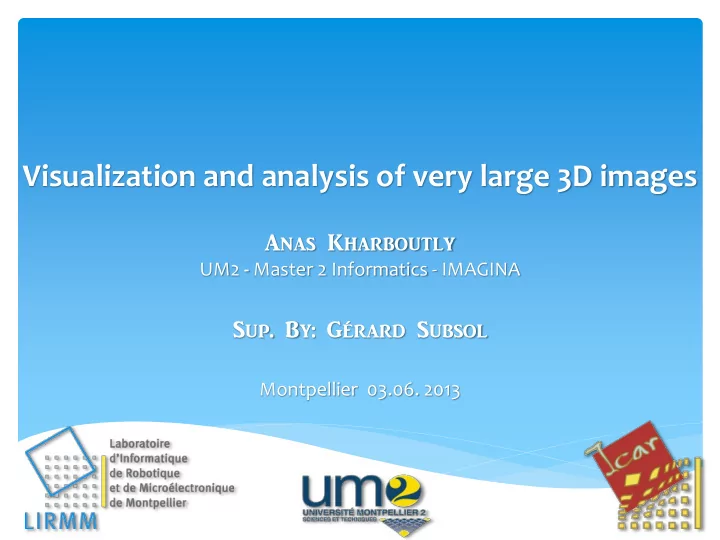

Visualization and analysis of very large 3D images Anas Kharboutly UM2 - Master 2 Informatics - IMAGINA Sup. By: Gérard Subsol Montpellier 03.06. 2013
The Main Problem Visualization and analysis of very large 3D images Very large 3D images: 2000*2000*2000 voxel Problems: Memory size Time Visualization window 2
Visualization
Visualization 2. Multi−scale coding [∗] 1. Blocks Decomposition [∗] Ihm, I., Park, S.: Wavelet-based 3D compression scheme for very large volume data. In: Graphics Interface .98, 107.116, 1998. 4
Visualization 1. Blocks Decomposition 5
Visualization Low Resolution View High Resolution Zoom View 6
Visualization Visualize LR version Select ROI & mouse click LR Version LR View HR View Down Call back the required blocks Visualize Sampling HR blocks Original version Block Decomposition Blocks Version Load the required blocks 7
Block Decomposition 4 4 Block Decomposition 2 Original Version Blocks Version Decomposition Factor (4,4,2) 8
Visualization Parameters Decomposition Factor: Two matters! 1. Block size & Required memory 2. Number of blocks & Required time 9
Visualization Parameters 1. Block size & Required memory (2D) Image size 800 * 800 Window size 100 * 100 Decomposition Factor (4,4) Decomposition Factor (8,8) Block size: 200 * 200 : 40 000 Block size: 100 * 100 : 10 000 Required Memory: 4 * (100*100) : 40 000 Required Memory: 4 * (200*200) : 160 000 10
Visualization Parameters 1. Block size & Required memory (2D) Memory 180000 160000 140000 120000 100000 80000 60000 40000 20000 0 0 5000 10000 15000 20000 25000 30000 35000 40000 45000 Block size 11
Visualization Parameters 2. Number of blocks & Required time Time Number of blocks 12
Visualization Parameters Down sampling parameters Down sampling factor along each axis Block decomposition parameters Number of blocks along each axis Configuration file (DF, BS, ZS) 13
Application of Visualization
Processing
Processing 1. Extract the connected components 2. Erosion 3. Dilation 4. Thresholding 16
Processing 1. Extract the connected components [∗] [∗] L.Apostol and F.Peyrin, Connectivity analysis in very large 3D microtomographic images. 17
Processing 1. Erosion 2. Dilation 3. Thresholding 18
Processing Sections 1. Preview the process list 2. Select a process and provide the parameters 3. Apply on LR version and show the result 4. Select ROI to apply this process 5. Add this process to the process list 6. (Creating a process list file and load an existing one) 19
Processing Problems 1. Problems of applying process’s operators 1. Erosion 2. Dilation 20
Processing Problem of Erosion Problem of Dilation 21
Processing Problems Problem of Erosion 22
Processing Problems Erosion on the blocks Correct Erosion 23
Processing Problems Problem of Dilation 24
Processing Problems Dilation on the blocks Correct Dilation 25
Processing Problems To get deal with such kind of problems: Two point of view 1. Increase the block size 2. Apply the process on the block’s neighbors. 26
Processing Problems 1. Increase the block size (Dilation 2D) 27
Processing Problems 1. Increase the block size (Dilation 2D) 28
Processing Problems 1. Apply the process on the block’s neighbors (Dilation 2D) 29
Processing Problems 2. Apply the process on the block’s neighbors (Dilation 2D) 30
Merci de votre attention
Questions
Recommend
More recommend